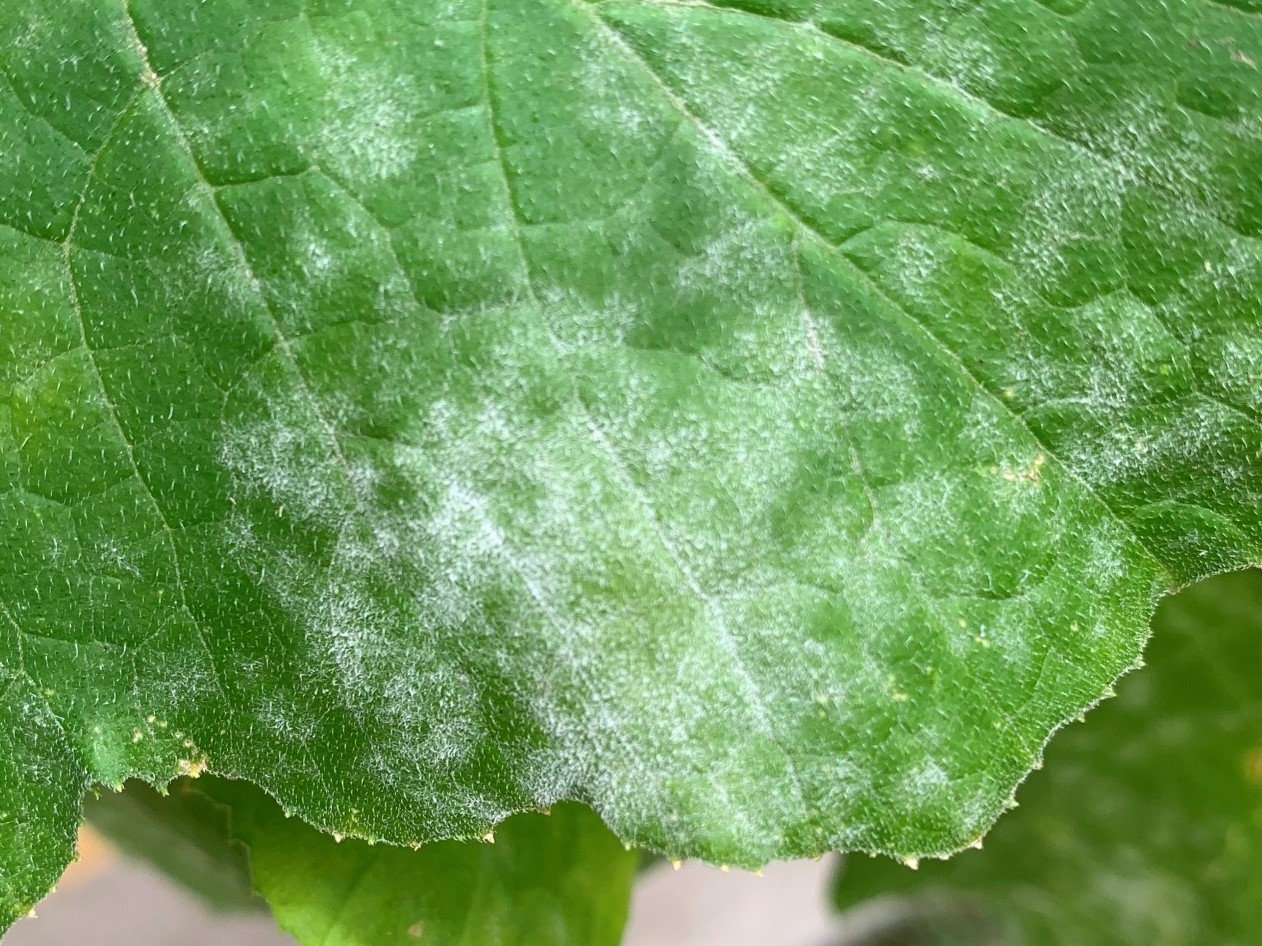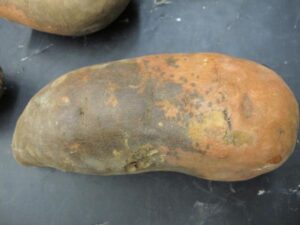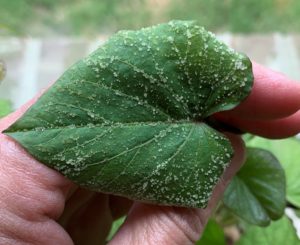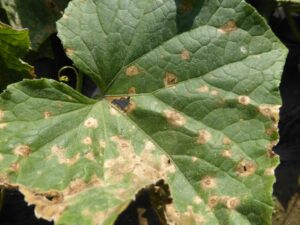What is Powdery Mildew?
Powdery mildew is a fungal disease that is caused by one of several different types of fungi, depending on the host plant. For many gardeners, it can be the bane of their gardening existence. If you haven’t experienced, just wait, you will.
This disease can affect all manner of plant life. But some of the more susceptible plants in the vegetable garden are cucurbits, such as cucumbers, yellow squash, acorn squash, patty pan (scallop) squash, zucchini, pumpkins, and melons.
How Do You Get It?
You can run from powdery mildew, but you can’t hide because the spores are spread by the wind. They are opportunistic and will take advantage of plants that are in a weakened state but can also thrive in a healthy garden. The fungus will overwinter in the soil and plant debris, only to re-emerge when conditions are favorable.
What Are The Symptoms?
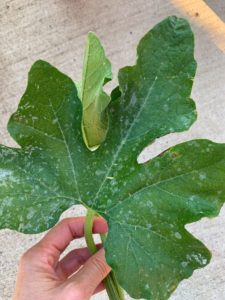
Powdery mildew will first appear as white or white-gray spots on the plant’s leaves before spreading to other areas. Some say it looks as if someone sprinkled baby powder on your plant. As it grows, it takes on more of a fuzzy appearance, with the spots getting larger.
At some point, the leaves will begin to turn yellow and eventually brown around the edges so that it appears they’ve been scorched by the sun. In addition, the leaf edges may curl upward. As the infection advances, it will affect fruit production, and if left untreated, the fungus will eventually destroy the plant.
It is important to properly identify powdery mildew as there are some varieties of squashes that have variegated leaves that may appear like they have mildew at first glance. What’s more, powdery mildew is often misdiagnosed as downy mildew. To learn how to distinguish between the two diseases, click here.
How to Prevent Powdery Mildew
While no one can control the wind that carries the spores to your garden, you can take measures to lessen the chances of it finding a hospitable environment.
Pretend it’s raining
One way to prevent powdery mildew from taking up residence in your garden is to occasionally spray the plants with water like it’s raining. I realize this suggestion may be somewhat controversial; we’re used to hearing the standard garden advice that says not to wet the leaves of your plants when you water. While this is generally good counsel because wet environments can lead to various fungal or bacterial infections, powdery mildew may warrant an exception. Some garden experts suggest that we should spray our plants because the spores are fond of humidity, but hate the rain. The fungus requires a dry, warm environment in order to propagate. When the plant is wet, the spores can’t spread. So once a week or so, if it hasn’t rained, water your plants from overhead. Don’t overdo it, though, as you could entice other pathogens to flourish.
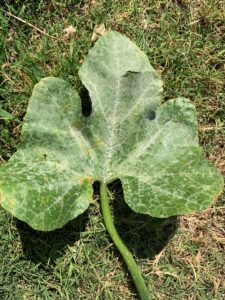
Go easy on the nitrogen
Powdery mildew likes to attach itself to new growth. By overwatering with a nitrogen-heavy fertilizer, you could inadvertently be putting out the welcome mat for the fungus. Instead, try using a slow-release fertilizer and be sure to follow the instructions for dosing and frequency.
Don’t crowd your plants
Plants living in close quarters means there is less airflow and diminished sunlight that is able to reach all parts of the plant, both ingredients for powdery mildew. To remedy the situation, leave adequate space between plants when populating your garden. Once the plants mature, prune them to ensure there is good air circulation; a must if you’re going to prevent the disease.
Plant resistant varieties
When possible, try planting varieties that are resistant to powdery mildew.
Mulch
Cover the soil with an inch or two or organic mulch. Not only will it create a barrier to keep any spores present in the soil from infecting your plants, but it will also help reduce the need to water.
Avoid stress
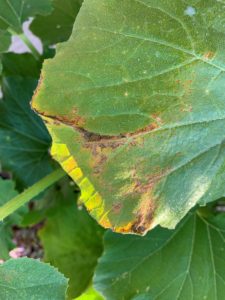
Plants under duress such as under or overwatering, for example, or from insect pressure, are more susceptible to all kinds of disease. Managing plant stress will help your stress level in the long run.
How To Organically Treat Powdery Mildew
But what if after all these measures your plants still get powdery mildew? First, know that you’re not alone. Even the most valiant efforts are sometimes not enough to keep this ubiquitous disease from your garden.
Next, consider using one of the following treatments. You may not be able to eradicate the mildew, but these should help you manage it. The fungus can be stubborn so you may need to try more than one method. For example, I alternate between the milk method and the baking soda solution.
The key to success is to treat your plants at the first signs of infection. Once powdery mildew gains a foothold, it can be difficult to eradicate, and you may need to pull the infected plant.
Milk Method

Mix 1 part milk with 8 parts water in a spray bottle. Almond milk, coconut milk, etc. will not work as they lack the necessary proteins found in animal milk. Spray all parts of the affected plant, including the underside of the leaves. Spray every week to ten days. Others recommend a ratio of 4 parts milk and 6 parts water for a more concentrated solution, sprayed every two weeks. Treat your plants during the day as the sunlight is needed to activate the proteins in the milk. It’s a good idea to always do a test spray on one leaf. After 24-28 hours, if there is no adverse reaction, proceed to treat the rest of the plant.
This article contains affiliate links. If you make a purchase using one of these links I will receive a very small commission at no additional cost to you, and it will help me maintain this website. Rest assured, I only recommend products I actually like!
Baking Soda Method
Household baking soda works by creating an alkaline environment that is inhospitable to the fungus. Add 3 tablespoons of baking soda with 1 tablespoon of vegetable oil of your choice, with several drops of Castile soap like Dr. Bonners or Dr. Wood’s, to 1 gallon of water. (Here is the gallon sprayer I use.) If you don’t have that available, use a liquid dish soap with the fewest added chemicals. Mix well.
Spray plant, especially the tops and undersides of all the leaves, once a week or so. Unlike the milk method, do not spray during the day as it could burn your plant. Instead, spray in the early morning or early evening. Do not save any leftover solution.
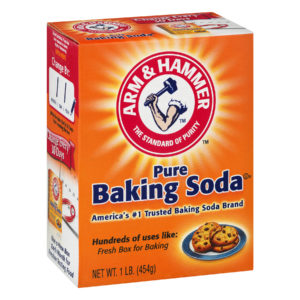 Baking soda can burn your plants. Be sure to do a test spray first on one leaf. Wait 24-48 hours to see how the plant responds. You may need to dilute the spray if there appears to be damage to the test leaf.
Baking soda can burn your plants. Be sure to do a test spray first on one leaf. Wait 24-48 hours to see how the plant responds. You may need to dilute the spray if there appears to be damage to the test leaf.
Also, according to The Old Farmer’s Almanac, baking soda can build up in the soil and cause calcium, magnesium and iron deficiencies.[1] This may not be as problematic in container gardening since watering flushes the soil more quickly than in a traditional garden bed. However, it is something to be aware of so that you don’t overdo it.
Potassium bicarbonate, a substance used in food and medicine, can be a good substitute for baking soda. It is said to be more effective against powdery mildew that has already taken hold of a plant as opposed to using it as a preventative measure. A possible spray solution would be to mix 3 tablespoons each of potassium bicarbonate and vegetable oil, 1/2 teaspoon of mild soap, like Castile soap, with a gallon of water. Be sure to do a test spray first.
Vinegar Method
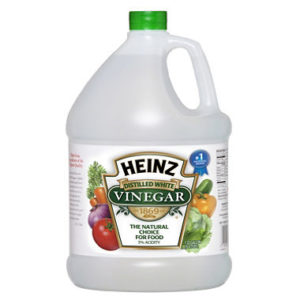 While not as popular as the first two methods, vinegar and water can be an effective solution, as well. Mix 2 to 3 tablespoons of vinegar (5% acidity) with 1 gallon of water. Spray the affected plant as in the previous methods, every three days. Do not spray in sunlight.
While not as popular as the first two methods, vinegar and water can be an effective solution, as well. Mix 2 to 3 tablespoons of vinegar (5% acidity) with 1 gallon of water. Spray the affected plant as in the previous methods, every three days. Do not spray in sunlight.
Vinegar, like baking soda, can burn your plants. Because of its acidity, exercise caution in repeated use. Be sure to do a test leaf before spraying your entire plant.
Neem Oil Method
Pure, 100% cold-pressed, organic, neem oil with azadirachtin, the naturally occurring compound in neem oil, can also be effective against powdery mildew. Many know it can be used as an insecticide, but it also works as a natural fungicide. Be sure to  follow the directions on the product label and always do a test spray. This is the brand I use.
follow the directions on the product label and always do a test spray. This is the brand I use.
Mouthwash Method
While somewhat unconventional and not organic, per se, some recommend using an ethanol-based mouthwash to treat powdery mildew. The thinking is that the germ-killing ingredients can be effective against the fungal spores.
Mix 1 part mouthwash with 3 parts water in a spray bottle. Spray in the same manner as above. Be sure to do a test spray.
Sulfur
Sulfur is a natural substance that is usually mixed with potassium salts, and other ingredients that may not be natural, to treat powdery mildew. It can be used as a fungicide as well as an insecticide. Sulfur works by disrupting the spore cell’s respiration. Note, however, that it can be harmful to human respiration as well.
What’s more, even though sulfur is listed as organic on the USDA National List of pesticides used for organic growers, one life sciences reporter writes that elemental sulfur has been “known to cause some harm to humans” and this should raise some eyebrows.[2] For this reason, and because there are other viable alternatives, I personally cannot recommend the use of sulfur in the garden.
Copper

Copper is a naturally occurring mineral that is combined with a fatty acid to make copper octanoate, or copper soap, to combat powdery mildew. However, it is also often combined with other chemicals, such as copper sulfate, which can be harmful. Several studies found that copper sulfate, although it is classified as organic and said to be safe to use in the garden, can be toxic to humans, animals, and honeybees.[3] As the Genetic Literacy Project reports:
It has been assumed for years that pesticides that occur naturally (in certain plants, for example) are somehow better for us and the environment than those that have been created by man. As more research is done into their toxicity, however, this simply isn’t true, either. Many natural pesticides have been found to be potential – or serious – health risks.[4]
One of the popular brands of copper fungicide that I researched also contains copper sulfate. Thus, in my opinion, I would refrain from using this chemical in my garden.
Others steps you should take to treat powdery mildew:
- Prune branches to provide ample airflow and sunlight. Do not add them to your compost bin as they could contaminate it with the spores.
- Remove affected leaves and thus minimize the spread. Do not add them to your compost bin.
- Be sure to clean your tools, garden gloves, spray nozzle, etc. afterward so the infection won’t spread by contacting healthy plants with contaminated items. Some recommend using rubbing alcohol, while others call for a bleach solution of 1 part bleach to 9 parts water. (You can learn more about the various options for disinfecting garden tools in his helpful article.)
- Keep the containers (or garden beds) clean as decaying matter is a haven for fungi.
- If all else fails, pull the plant and throw it away. Do not add it to your compost it pile as it will contaminate it.
- The majority of the resources I’ve consulted recommend not using the soil that housed an infected plant as the spores can remain for three years. A few, including an organic master gardener,[5] suggest the soil can be used to replant in provided the new plant isn’t as susceptible to powdery mildew as its predecessor. You’ll want to make a decision based on what’s best for you and your garden.
Powdery mildew is a part of the gardening experience. Hopefully, with a little effort, you can effectively treat, if not avoid it altogether.
Note: If you found this article to be helpful, please share it with someone you think might be interested via email or social media. Thank you!
[1] Powder Mildew Remedy for Plants, The Old Farmer’s Almanac, 1-29-19, accessed 7-6-20, https://www.almanac.com/news/gardening/gardening-advice/powdery-mildew-remedies-plants
[2] Andrew Porterfield, ” Myth Busting on Pesticides: Despite Demonization, Organic Farmers Widely Use Them Widely,” Genetic Literacy Project, 12-2-16, accessed 7-7-20, https://geneticliteracyproject.org/2016/12/02/myth-busting-on-pesticides-despite-demonization-organic-farmers-widely-use-them/
[3] Andrew Porterfield, “Organic Fungicide Copper Sulfate Poses Dangers to Humans, Animals, Insects—How Does It Compare to Conventional Pesticides?” Genetic Literacy Project, 11-16-18, accessed 7-7-20, https://geneticliteracyproject.org/2018/11/16/organic-fungicide-copper-sulfate-poses-dangers-to-humans-animals-insects-how-does-it-compare-to-conventional-pesticides/
[4] Ibid.
[5] Growing in the Garden, accessed 6-30-20, https://growinginthegarden.com/how-to-prevent-and-treat-powdery-mildew/
